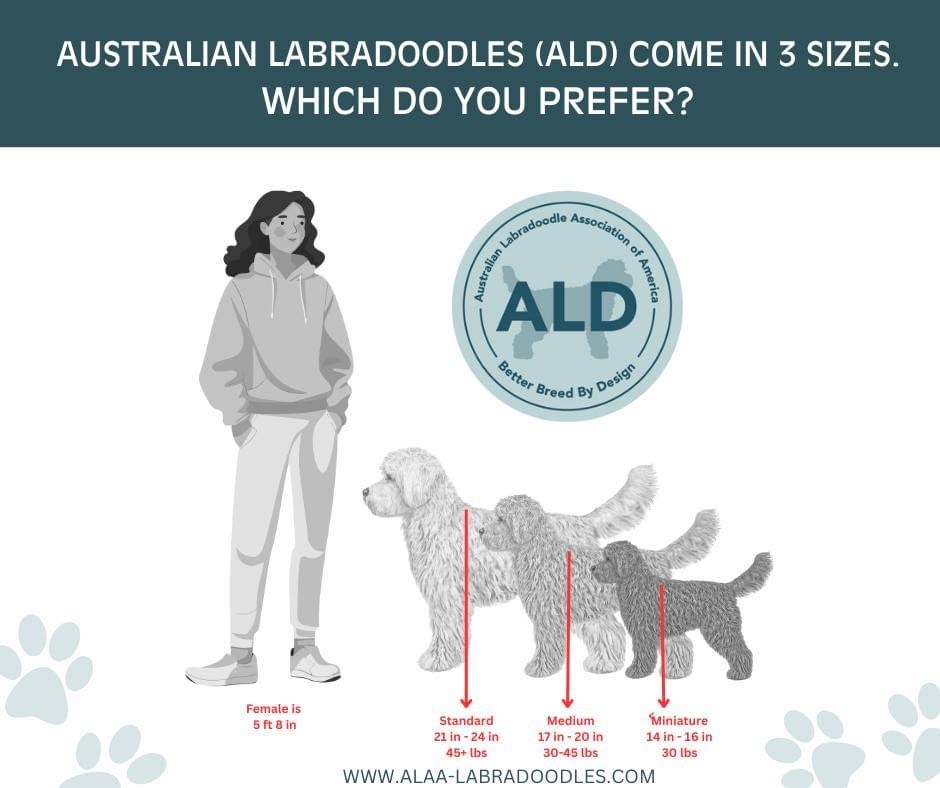
Early Beginnings
The Labradoodle was first intentionally bred in 1989 by Wally Conron of the Royal Guide Dogs Association of Australia. Conron’s goal was to create a guide dog suitable for people with allergies. He crossed a Labrador Retriever, known for its excellent temperament and trainability, with a Poodle, known for its low-shedding coat. The initial success of this crossbreed generated significant interest due to its hypoallergenic potential and friendly disposition.
Development of the Australian Labradoodle
Following the initial creation of the Labradoodle, breeders in Australia began to develop the breed further. The Australian Labradoodle differs from the standard Labradoodle in that it incorporates additional breeds into its lineage to enhance specific traits. The breed includes the English and American Cocker Spaniel. However, it is reported that the Curly Coat Retriever, and the Irish Water Spaniel were also introduced into some early lines. Breeders focused on creating a consistent, multi-generational dog with a stable temperament, non-shedding coat, and low allergenic properties. Over several generations, they selected for traits like intelligence, sociability, and overall health.
Recognition and Standardization
Although the Australian Labradoodle is not officially recognized as a purebred by major kennel clubs like the American Kennel Club (AKC), Australian Labradoodle Association of America (ALAA) is an organization that is specifically dedicated to the breed. The ALAA works towards maintaining breeding standards and promoting the health and well-being of the breed. We are proud ALAA members!
Popularity and Modern Day
Today, the Australian Labradoodle is popular as both a companion and therapy dog. Its friendly nature, trainability, and hypoallergenic coat make it a favorite among families and individuals with allergies. The breed’s versatility and endearing personality continue to contribute to its rising popularity around the world.
Physical Characteristics
Size: Miniature (15-25lbs), Medium (30-45lbs), and Standard (50-65lbs)
Coat: Wool, Fleece, or Hair, and are often curly or wavy. They are low-shedding and hypoallergenic.
Colors: They can come in a wide variety of colors, including chocolate, cream, gold, caramel, apricot, black, red. Patterns include parti, phantom, tuxedo.
People love the Australian Labradoodle for several reasons:
Hypoallergenic Qualities
Low-Shedding Coat
Their coats are low-shedding, which makes them more suitable for people with allergies. This hypoallergenic quality is a major attraction for many prospective dog owners.
Friendly and Sociable Nature
Temperament: They are known for their friendly, gentle, and sociable nature. This makes them great companions for families, children, and other pets.
Affectionate: They are affectionate and enjoy spending time with their human companions, providing excellent emotional support.
Therapy and Service Dogs: Their calm and friendly demeanor also makes them excellent candidates for therapy and service dog roles.
Intelligence and Trainability
Ease of Training: Australian Labradoodles are highly intelligent and eager to please, which makes them relatively easy to train. They respond well to positive reinforcement techniques and can learn a variety of commands and tricks.
Adaptability: They are adaptable and can thrive in various living environments, including apartments and houses with yards, as long as they receive adequate exercise.
Appearance
Cute and Attractive: Their often curly or wavy coats and expressive faces make them visually appealing. They come in a variety of colors and sizes, providing options for different preferences.
Health and Longevity
Healthier Breed: Due to their mixed heritage, Australian Labradoodles often benefit from hybrid vigor, which can result in a healthier dog with a longer lifespan compared to some purebred dogs.
Versatility
Multifunctional: They excel in various roles, from family pets to working dogs, including roles as guide dogs, therapy dogs, and assistance dogs for people with disabilities.
Community and Support
Breeder Support: We offer ongoing support and resources for new owners, which helps ensure a positive experience with the breed. You can also register your puppy with ALAA Pet PALs. Link to Pet PALs

